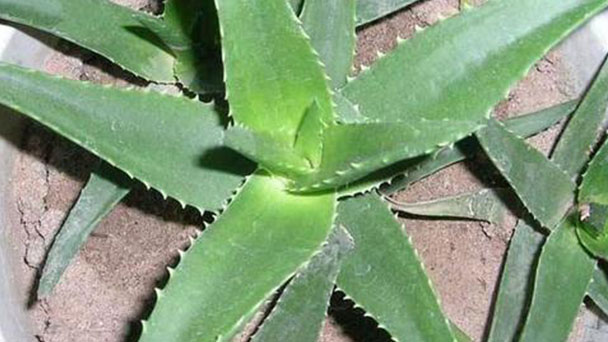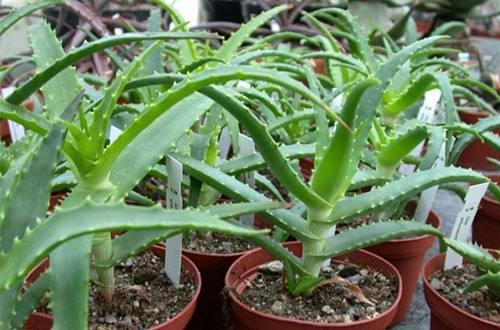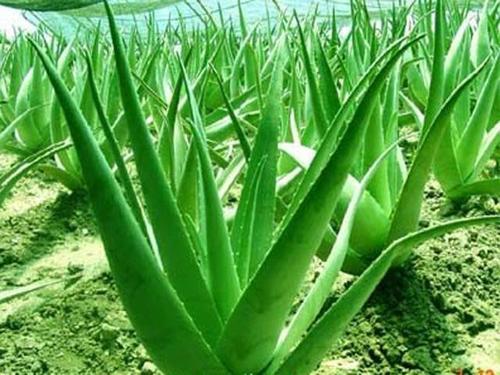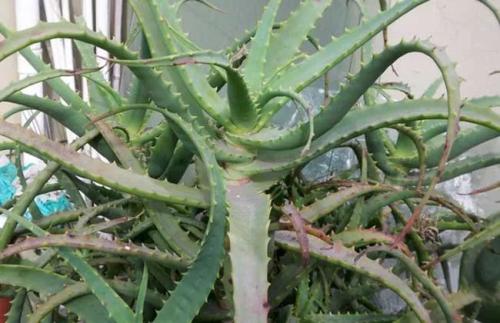Aloe Arborescens ( Krantz Aloe) Profile
Written by Maggie
Dec 06 2021

Aloe arborescens (also known as krantz aloe or candelabra aloe, Torch aloe) is a perennial plant with short or conspicuous stems and fleshy leaves clustered in rosettes or sometimes in dichroids, with sharp tips and often stiff teeth or spines at the edges. Aloe arborescens is native to South Africa with extremely bitter leaf juice.
Aloe arborescens picture

Aloe arborescens info
| Botanical Name | Aloe arborescens |
| Common Names | Krantz aloe, Candelabra aloe, torch aloe, tree aloe, mountain bush aloe |
| Plant Type | Evergreen shrub |
| Sun | Full sun |
| Hardiness Zones | 9b-11, USA |
| Flower color | Red to orange |
| Native Area | Eastern and southern Africa |
| Mature size | Six to nine ft height, six to nine ft width |
Morphological characteristics of Aloe arborescens
Aloe arborescens stems are up to 1 to 2 meters high, the stem of the long lateral bud, the shape of the tree.
Leaf
The impeller is born, 3~4 cm wide, about 30 cm long, 1~1 thick.5 cm.Orange-red flowers bloom in autumn and winter.Growing for more than two years, the weight of a single leaf about 40 grams.
Flowers
Scapes of Aloe arborescens drawn from leaves; Flowers arranged in a raceme or umbels; Perianth is cylindric, sometimes slightly curved; Outer wheel usually 3 perianth segments connate to the middle; Aloe arborescens has 6 stamens, inserted at base; Filaments are longer, anthers indented; Style is slender, stigma small. Capsule with many seeds.
Aloe arborescens is native to South Africa and has bitter leaves. Today it is commercially produced in Japan, where Aloe Arborescens is considered the best medicinal Aloe. Aloe vera powder was processed with Aloe arborescent. It can cure all kinds of diseases. In medicine, Aloe Arborescens has been tested to contain a number of active ingredients and is recognized as the most effective variety.
Ecological habits of Aloe Arborescens
Aloe arborescens have strong resistance to drought and cold. Aloe arborescens is not resistant to water moisture, soil too wet easy root rot, the growth rate in general.
The distribution of Aloe arborescens
Aloe arborescens are mainly distributed in Africa, especially in the arid areas of southern Africa, and also in southern Asia.
How to grow and care for Aloe arborescens
Light
Aloe arborescens is a plant for places with direct, severe sunlight. The shade of the leaves relies upon on the quantity of daylight the plant gets, ranging from stupid inexperienced to yellow-green or bluish-green.
Soil
Excellent draining is crucial, which solely mild and sandy or medium loamy soil can provide. Just like in its native habitat, the plant can develop in nutritionally negative rocky soil.
It is additionally salt-tolerant and can be planted in coastal areas.
Water
Aloe arborescens is nicely tailored to dry soil and even drought however does not now tolerate moist soil. Too much moisture, terrible drainage, and standing water can lead to plant death.
When irrigating at some stage in the developing season, let the soil dry out between watering. In the winter, if there is no precipitation, water is simply sufficient to hold the soil moist. Reduce the quantity of water each and every time you water. In the spring, if there is no rain, step by step restart watering.
Temperature and humidity
Like many succulents, Aloe arborescens does no longer do properly in excessive humidity.
It can tolerate reasonable frost with temperatures down to 25 tiers Fahrenheit.
Fertilizer
Aloe arborescens does not want an awful lot of fertilizer. Depending on how wealthy your backyard soil is, it may no longer want any at all.
Potted Aloe arborescens are different, as the vitamins wash out from customary watering. Adding a liquid fertilizer about as soon as each month is sufficient. Stop fertilizing at some point of the winter.
Propagating Aloe arborescens
Rather than developing Aloe arborescens from seeds, which is prolonged and involved, the best and most profitable propagation techniques of aloe is from suckers or shoots referred to as pups, or from stem or department cuttings.
In the spring, cast off the pups with as many intact roots as viable and transplant them into backyard soil or containers.
Stem or department cuttings are additionally eliminated in the spring. They want to be left to callous over for a day or two to callous over earlier than transplanting them into succulent or cactus potting mix. The steps are incredibly a whole lot the same as for propagating aloe vera.

Growing Aloe Arborescens in containers
If your neighborhood local weather is too bloodless for planting krantz aloe outdoors, you can additionally develop it in containers on a patio and convey it indoors for the winter. The fine vicinity is a southern or southwest-facing window, the place it receives masses of bright, oblique light.
To accommodate the roots, which aren’t deep, use a huge container with holes that make sure correct drainage due to the fact the plant virtually dislikes moist feet. To make certain enough drainage, plant it in industrial cactus or succulent combine as an alternative than ordinary potting mix.
When grown in containers, the Aloe arborescens want to be watered greater often than in backyard soil. Be careful, however, now not to overwater them, and do away with a saucer so the plant does now not sit down in extra water.
Although Aloe arborescens is a gradual grower, it will in the end outgrow its pot and will want to be repotted.
Aloe arborescens pests & diseases
Deer depart Aloe arborescens alone. As for pests it would possibly be affected with the aid of mites, mealybugs, tender scale insects, and aphids.
Functions and uses of Aloe arborescens
In 1996, the Food and Agriculture Organization of the United Nations (FAD) compared the nutritional value and composition of plants and fruits in the world, and the result was "Aloe arborescens, aloe vera" ranked first, and was hailed as "one of the best health food in the 21st century". Many medical circles have explored the effects of 1.5 million plants on the human body. Aloe vera has become one of the most ideal herbal medicines to prevent and cure various diseases. China's Ministry of Health in 2002 document 51 formally included aloe in the list of health food.
Nutritional value
Modern science has proved that there are hundreds of known and unknown chemical components in Aloe arborescens, among which nearly 100 chemical components have been clearly studied and applied. aloe arborescens leaves are filled with a healthful Androgel that contains many valuable nutrients, including vitamins, minerals, enzymes, oils (fats), amino acids, and mucoglycan, which has therapeutic properties. In the chemical composition of the largest content of active components are aloin, aloin emodin, aloin, aloin polysaccharide, aloin saponins, but also a variety of amino acids, organic acids, cellulose, active substances, enzymes, trace elements, etc..70 kinds of nutrients (polysaccharides and amino acids), 20 kinds of organic acids, 20 kinds of minerals, 30 kinds of alkanes and 10 kinds of enzymes have been found. The content of water in fresh leaves of aloe vera is 99%-99.5% by weight. This kind of water is the original natural biological water, which plays an important role in beauty, health care, medical treatment and so on.
Aloe arborescens is also called tree Aloe and wooden sword Aloe. In Japan, the stem height up to 1~2 meters, the long side bud on the stem, its shape like a tree. The impeller is born, 3~4 cm wide, about 30 cm long, 1~1.5 cm thick. Orange-red flowers bloom in autumn and winter. Grow more than two years, single-leaf weight about 40 grams, old leaves are good. It contains anti-cancer ingredients, can treat diabetes, etc., and is considered the best medicinal varieties by the Japanese.
Dietary value
Aloe arborescens is a simple way to eat and can strengthen the body. In Australia, New Zealand, India, Thailand, Singapore and other countries, residents take aloe vera as a common thing. Eating fresh aloe vera is a good way to keep your family healthy. The following are the following:
1. Raw chewing aloe leaf namely cut fresh aloe leaf into 3cm to 4cm segments, wash and peel;
2. Food aloe juice is to take aloe leaves after breaking and filtering in soybean milk machine. It is best to beat them with the use or keep them in the refrigerator for 1 to 2 weeks after boiling.
3. Decocting and taking is similar to traditional Chinese medicine;
4. Aloe arborescens raw leaf powder cut the fresh leaves into thin slices in the microwave oven to bake crisp and then grind into powder.
5. Aloe arborescens wine can refer to other fruit wine methods. Generally, the ratio of aloe vera wine and 50-degree liquor is 1:1.2 and can be drunk after 3 to 4 weeks. In addition, there are aloe honey infusions, aloe fresh leaf tea and so on.
But in the consumption of aloe must be careful, aloe contains aloe-emodin has the effect of "catharsis", eat too much, will inevitably lead to diarrhea. If it is constipation patients, you can eat a little more, in order to facilitate its effect; If its spleen and stomach deficiency cold, it is better to eat less.
Medicinal value
In terms of medicine, leaves of Aloe arborescens can be eaten raw and squeezed into juice, as well as processed into health food or cosmetics. Because it is easy to handle, it is also suitable for use as an edible home dish. Aloe arborescens was early recognized as a folk herb, and the popular civilian Aloe vera refers to this Aloe arborescent.
Aloe arborescens gained attention, development and research thanks to the "World War II" period, in which the amazing discovery was that the United States dropped two atomic bombs on Nagasaki and Hiroshima in Japan, and a large number of survivors were burned by the atomic isotope radiation. When any medical treatment fails, someone daubs the wound with "Aloe arborescens", and the miracle appears, the wound heals quickly and well. This other drug regenerates twice as fast, leaving no mark on the wound. Since then, scientific research has been carried out in Japan and the United States. The Japanese scientists mainly studied "Aloe arborescens", which not only contains
Efficient anti-cancer ingredients, but also improve the body's immunity, but also without side effects. American experts mainly study the "American Curacao" called aloe vera as the "natural king of detoxification" that can enhance human metabolism. The US food and drug administration uses aloe vera as a treatment for burns and radiation burns, and has determined that it is very effective in regenerating and healing skin tissue.

Read More:
Latest Updated
- Benefits of Bugleweed - 7 Science-backed Health Benefits
- Bugleweed Dangers & Side Effects - Is It Poisonous?
- How to Plant Evergreen Trees - What You Should Know
- When to Plant Evergreens - Grow Guide for Evergreen Trees
- 12 Wonderful Evergreen Shrubs for Your Garden
- 12 Popular Evergreen Plants with Pictures for Beginners
- When And How To Prune A Lilac Bush Like a Pro
- How to Grow & Care for Lilac Vine (Hardenbergia Violacea)
- Japanese Lilac Tree (Syringa Reticulata) Care & Propagation Guide
- Shumard Oak Pros and Cons - What to Know
Popular Articles
- Winter maintenance of Antirrhinum Majus
- How to Grow Terminalia Mantaly Tree
- How to Grow and Care for Crossostephium Chinense
- How to grow Antirrhinum Majus in spring
- Peristeria Elata (Dove Orchid) Profile: Info & Care Guide
- Underwatered Snake Plant (Sansevieria Trifasciata) - Signs And How To Fix
- How to Care for Brazilian Jasmine Plant (Mandevilla Sanderi)
- How to Grow & Care for Graptopetalum Purple Delight in Summer
- Rosa Chinensis (China Rose): Plant Growing & Care Tips
- How to Care for Baby Sun Rose (Aptenia Cordifolia)